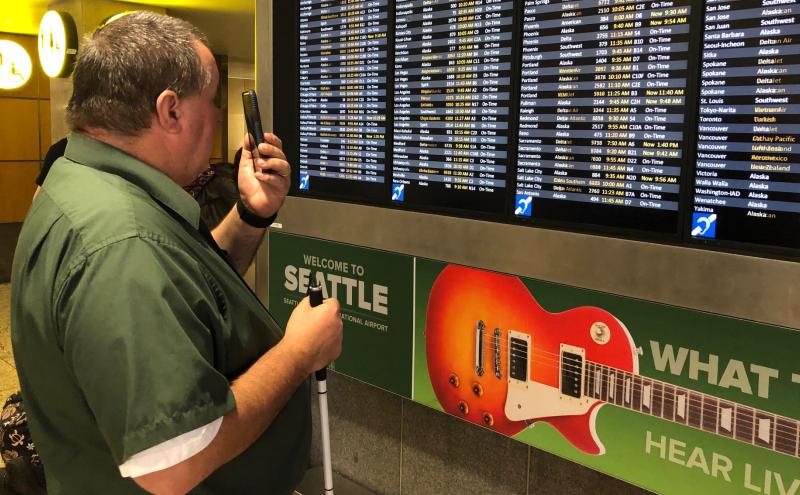by Heather Karch and Chelsea Rodriguez
Did you know that almost 25 percent of Washington adult residents have some type of disability, whether it’s hearing, vision, cognitive, an ability to live independently, or ambulatory? We’re committed to making SEA one of the most accessible airports in the country and want to highlight a few ways we are improving the travel experience for all.
July 26 marks the 30th anniversary of the passage of the Americans with Disabilities Act (ADA), a landmark law that prohibits discrimination based on disability. The ADA protects individuals with physical and mental disabilities, and we applaud the ADA’s positive impacts on people with disabilities and our entire community. By prohibiting discrimination against people with disabilities, the ADA has helped ensure that people with disabilities can fully participate in our community, which strengthens our community as a whole. At SEA, we evaluate each project or initiative through an accessibility lens to ensure that all passengers benefit as we continue to improve our operations, customer experience, and facilities.
According to ADA.gov “The ADA is one of America's most comprehensive pieces of civil rights legislation that prohibits discrimination and guarantees that people with disabilities have the same opportunities as everyone else to participate in the mainstream of American life — to enjoy employment opportunities, to purchase goods and services, and to participate in State and local government programs and services.”
In honor of the ADA Anniversary, here are five accessibility highlights at SEA that will make travel easier for all of us:
1. Sunflower Lanyards
SEA was the first U.S. airport to offer sunflower lanyards to passengers with hidden disabilities, such as autism, PTSD, or hearing loss. First pioneered at Gatwick International Airport in London, the sunflower lanyard communicates that passengers wearing it may need extra help while traveling. Because not all disabilities are visible, the sunflower lanyard is a way to discreetly signal to staff that extra assistance, patience, or understanding may be needed.
We have distributed 250 lanyards since the start of the program in October 2019 and look forward to distributing many more as flight travel increases.
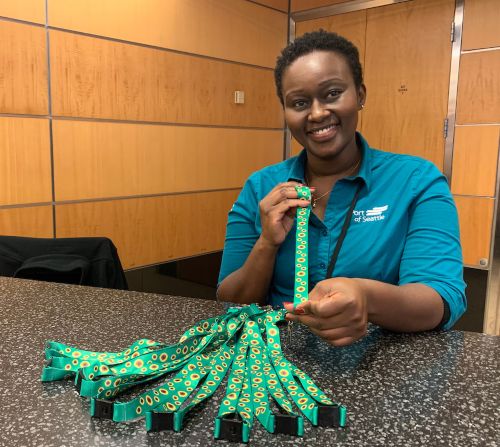
Program participation is voluntary and intended to increase transparency and empathy for passengers while travelling through SEA Airport. Passengers may request free sunflower lanyards at the information desk before security between Checkpoint 3 and Checkpoint 4 (near the Starbucks and US Bank). This desk is staffed from 7:00 a.m. to 9:00 p.m. seven days a week. Passengers should coordinate in advance with their airlines and TSA Cares for travel and accommodation assistance.
2. Friendly facilities for furry helpers
Pet relief areas
The ADA protections also apply to service animals assisting people with disabilities. SEA Airport has five pet relief areas, both outside and inside security. We are committed to ensuring service animals have a clean relief space just like all other passengers.
- For full details on these locations, download the SEA App or visit our travelling with pets page.
Animal therapy program
Although presently “paws-ed,” due to COVID-19, our animal therapy program was created to enhance everyone’s experience at the airport. Nothing can bring more calm and joy to anxious travelers then a wagging tail and a furry friend. Flying and being in a busy airport setting can be a stressful experience. Our animal therapy teams are registered through Pet Partners and provide a calming presence.
- Meet Joanne and Gracie, our animal therapy team
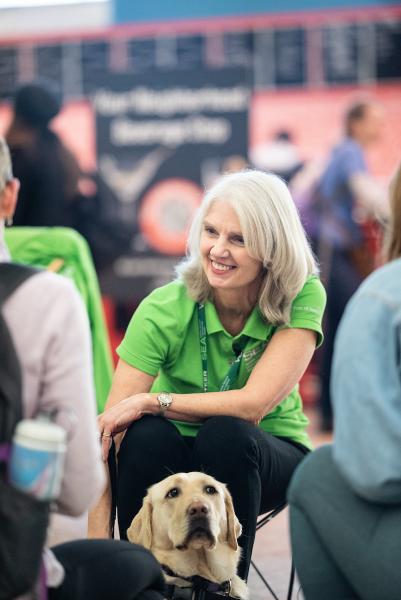
3. Vision and Auditory Assistance
Aira service
Since 2018, we have partnered with Aira (pronounced EYE-rah) to help travelers who are blind and have low vision safely navigate the airport. Aira connects users to live agents through a mobile app and/or assistive smart glasses to navigate every step of the airport, from the curb and check-in area all the way to the gate.
SEA was the first airport on the West Coast and one of the first airports in the nation to join the Aira Airport Network and covers the cost of the Aira minutes for any travelers using the service while in the airport. Remember to take advantage of the free Wi-Fi network while travelling.
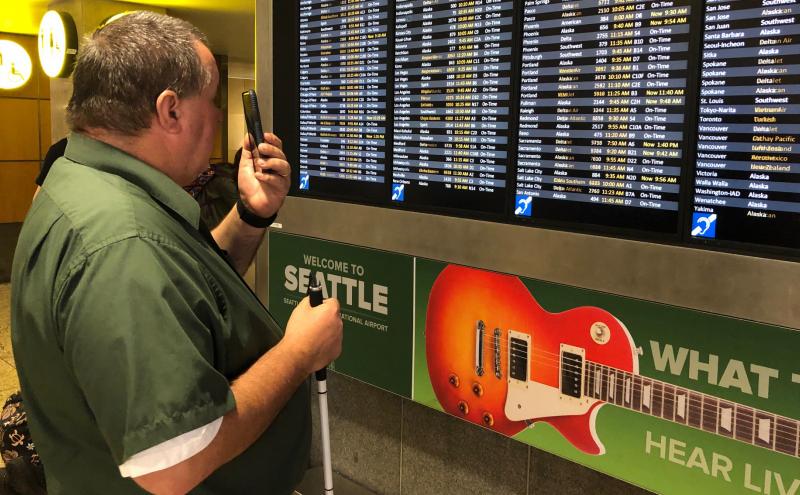
Pathfinder assistance
Our Pathfinder customer service team is a great resource for passengers with hearing loss or who do not speak English. The Pathfinders carry tablets equipped with the Language Line app that provides live translation for over 100 languages including American Sign Language. To keep everyone safe during COVID-19, we are exploring alternative communication options for frontline staff to better communicate with passengers with hearing loss who read lips.
Apps for ordering
Several apps, paired with a cell phone text reader, can help travelers who are blind or low vision do advance research, order, and pick up meals at airport restaurants. You can read or listen to the menu on your cell phone, pay, and place an order using technology.
4. Nursing and Changing Facilities
Our newly renovated North Satellite includes two additional amenities, a state-of-the-art Nursing Room and an adult changing table.
Nursing Suite
The Nursing Suite features three privacy rooms, a private restroom, sinks, changing tables, seating and other amenities to ease the stress of traveling for families. New artwork by local artists Lauren Boilini, Malayka Gormally, Leah M. Nguyen, and Tyna Ontko will be added to the space in the coming months.
For families, we continue to have Mamava, or modular nursing spaces, located on each Concourse for your convenience. Please reference map of current locations. All Mamava units are wheelchair accessible and are lockable, private spaces with a table and outlet.
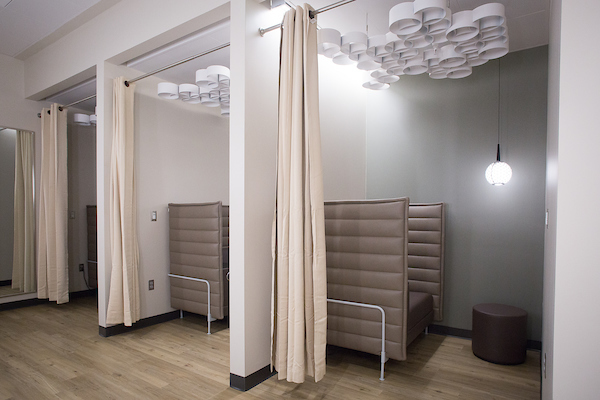
Adult Changing Tables
A future addition of an adult changing table in the upcoming International Arrivals Facility (IAF) is set to open in early 2021.
5. Sensory Room
SEA Airport will be opening our first Sensory Room in Fall 2020. The room is designed to address the needs of passengers with autism, sensory processing disorders, or those who need a calming recovery space from the sights and sounds of the airport. It will be a safe space for families or individual passengers with neurological or developmental disabilities. The Sensory Room is designed with special lighting, furniture, and materials to help passengers prepare to travel or recover from their journey. The room will be located within the train station beneath the A gates.
Future Accommodation
In 2021, SEA Airport will be expanding the reach of current initiatives like distributing more Sunflower Lanyards and increasing the size of our animal therapy program.
Our goal at SEA is to be creative and innovative in making our customer service, operations, and facility more inclusive. Throughout technology and apps, the joy of therapy animals, or improved spaces like Nursing Suites and the Sensory Room, we want to address your specific needs and improve your experience. Our community is a richer place when everyone can fully participate. Happy Anniversary to the ADA and its long-lasting impacts.


